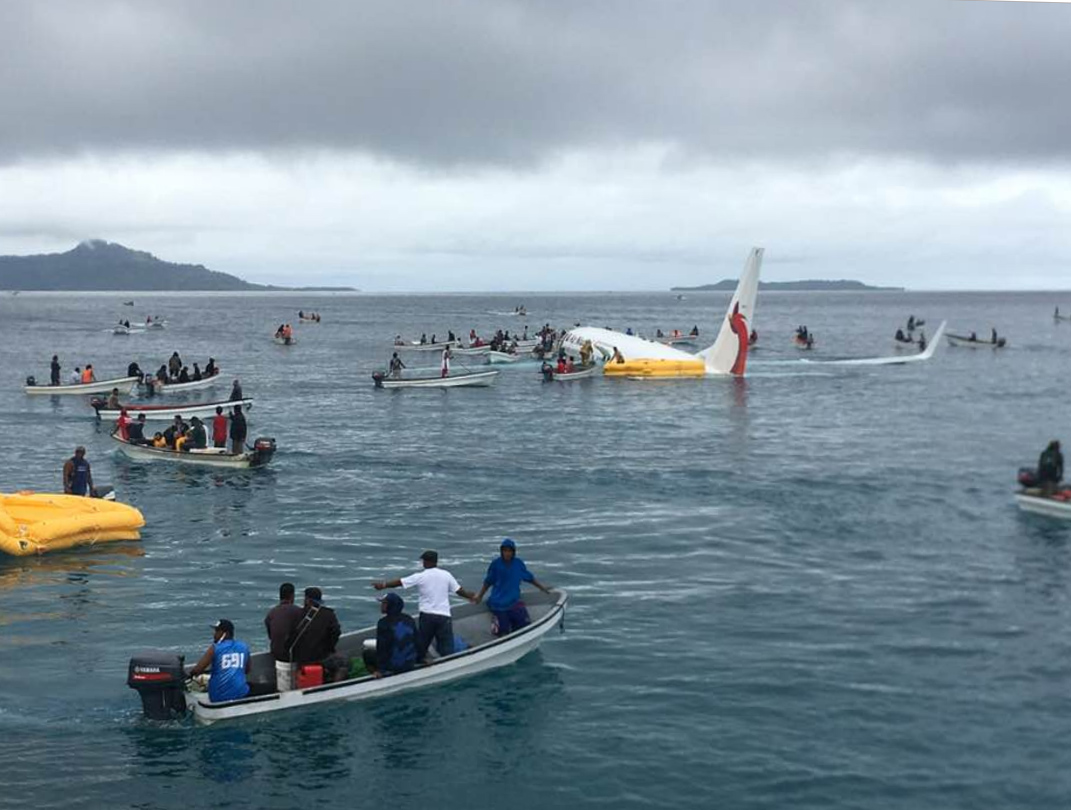Air Niugini crew ignored alerts prior to ditching
18 July, 2019
5 min read
By joining our newsletter, you agree to our Privacy Policy


The crew of an Air Niugini Boeing 737 that ditched into a lagoon in Micronesia did not follow the airline’s standard operating procedures and ignored a string of ground proximity alerts.
A report by the PNG Air Accident Commission found the crew did not comply with the approach and pre-landing checklists and the approach procedure was not adequately briefed.
It found the pilots heard but disregarded at least 13 aural alerts from the enhanced ground proximity warning system as the aircraft landed in heavy rain at an excessive rate of descent.
The aural alerts were among 16 alerts about the sink rate and the glideslope received during the descent in addition to a visual warning to “pull up”.
The Boeing 737-800 was operating a scheduled passenger flight Pohnpei to Chuuk in the Federated States of Micronesia with 37 people on board on September 28, 2018, when it plunged into the lagoon about 1500ft short of the runway threshold.
Six people were seriously injured in the crash and one died.
READ: Air Niugini undershoots runway and ends up in the ocean.
Investigators had access to additional information because an engineer was in the cockpit during the crash and recorded the landing on his phone from about 3000ft for recreational purposes.
The report found the approach selected by the pilot in command required a flight path descent angle of 3 degrees but the aircraft was flown at a steep rate of descent averaging 4.5 degrees during the approach with lateral over-controlling that meant it was unstabilized.
The Flight data recorder recorded a total of 17 enhanced ground proximity warnings, eight “sink rate” and nine “glideslope” , with 14 aural alerts after passing the minimum descent altitude.
A “100ft” advisory overrode one of the glideslope aural alerts.
Both pilots failed to recognize the danger, and the co-pilot was ineffective as the support/monitoring pilot, investigators said.
“The crew of P2-PXE were fixated on the task of landing the aircraft and did not notice the visual PULL UP caution alert at the bottom of their PFD,’’ the report said.
“Therefore, they (crew) did not take any positive action to arrest the high rate of descent and avoid landing in the lagoon.
“ In fact, neither of the pilots were aware of the rapidly unfolding unsafe situation.
“The investigation found that the crew had received similar aural alerts on previous approaches in visual conditions where the aircraft was safely landed.
“This would have contributed to the perception that the alerts during the accident approach were nuisance alerts, and therefore disregarded them.”
The pilot in command did not conduct a go-around after passing the minimum approach altitude and subsequent minimum descent altitude despite reasons to do so.
These included the weather, an unstable approach, the rate of descent, glideslope indicator cues, the EGPWS aural alerts and visual “pull up” warning message on the flight display.
“Both pilots were fixated on cues associated with control inputs for the landing approach, and subsequently, were not situationally aware and did not recognize the developing significant unsafe condition of an increasingly unstable final approach,’’ PNG Air Accident Commission Hubert Numani said in a media release.
“The Air Niugini Standard Operating Procedures Manual (SOPM) instructs a non-flying support pilot to take control of the aircraft from the flying pilot and restore a safe flight condition when an unsafe condition continues to be uncorrected, in particular an unstable approach when the aircraft is in IMC and below 1,000ft.
"However, the copilot as the non-flying support pilot did not do so.
“The pilot in command did not carry out the required go-around at the Minimum Descent Altitude.”
A contested recommendation in the report was that a continuous “whoop whoop pull up” hard aural warning in conjunction with the visual alert could have been effective in alerting the crew to the imminent danger and may have prevented the accident.
The US National Transportation Safety Board, which was a party to the investigation, disagreed the additional warning would have been effective in alerting the crew.
“NTSB staff believes that the actions of the pilots to disregard the 16 EGPWS alerts and to not comply with Air Niugini policy clearly demonstrate that the crew was unresponsive to guidance that should have prompted a clear and decisive action to initiate a missed approach,’’
“ NTSB staff believes the disregard of the alerts, disregard of the PFD display guidance, and the continuation of an unstable approach demonstrate that any additional guidance, alert, or warning would be similarly disregarded by the flight crew and ineffective in preventing the accident.”
EGPWS manufacturer Honeywell also noted that if made the change it would be unable to certify the system with the US Federal Aviation Administration.
A slew of other recommendations related to flight crew training and testing, standard operating procedures and manuals, safety cards and aircraft evacuations.
“It is important to note that none of the safety concerns brought to the attention of Air Niugini caused the accident,’’ Namani said.
“However, in accordance with International Standards, identified safety deficiencies and concerns must be raised with the persons or organizations best placed to take safety action so as to impede recurrence of similar events.
“Air Niugini Limited took prompt action to address all the AIC’s identified safety concerns in an average time of 23 days from the date of issue by the AIC.”
As a result of the access to the engineer's video, the AIC also recommended that the PNG regulator conduct a Notice of Proposed Rule Making to require “cockpit imagery in aircraft for safety enhancement”.
Get the latest news and updates straight to your inbox
No spam, no hassle, no fuss, just airline news direct to you.
By joining our newsletter, you agree to our Privacy Policy
Find us on social media
Comments
No comments yet, be the first to write one.

